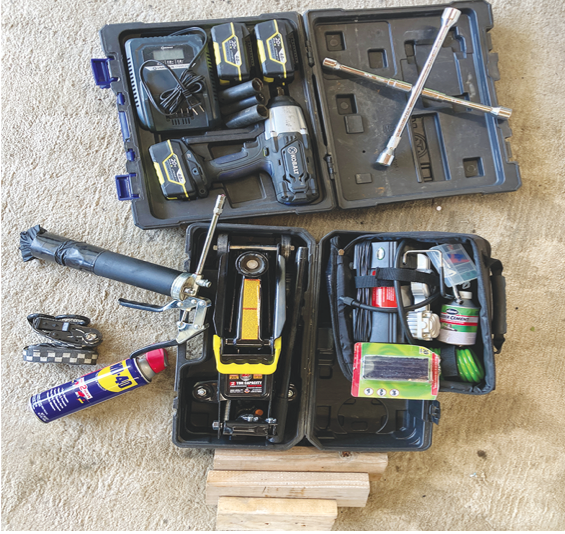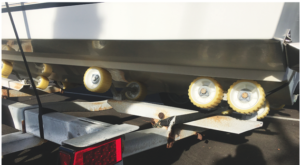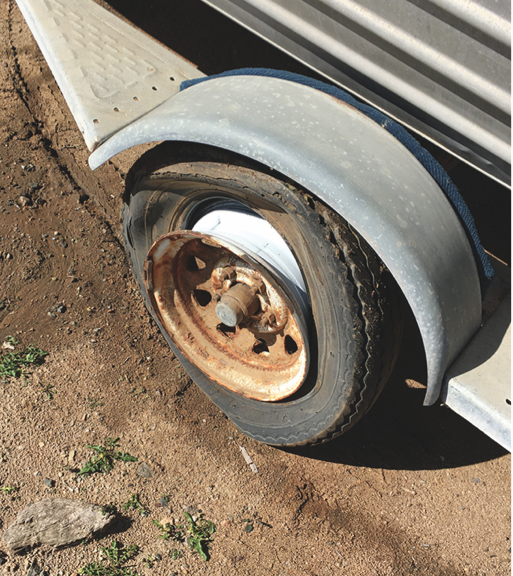
BY DANIEL LABARBERA
When talking to boat owners, the running joke is, what does B.O.A.T. stand for? “Bust Out Another Thousand” is the answer most boat owners reply with. It’s true, boat ownership is expensive, and there’s always something that can be upgraded or fixed. It’s rare to find a boater that is completely satisfied with their vessel. Things can always be improved and maintenance is a constant. Within the long list of boat maintenance and upgrades, more often than not, trailer maintenance and travel prep seem to get pressed down to the bottom. This guide will get you to and from your destination with confidence. There’s nothing worse than being stranded on the side of the road unprepared. Listed below is what I have and what I do before most long trailer runs. The kit below is a must and the procedures are up to your interpretation.
The boat trailer travel kit:
• Floor jack, scissor jack, and/or bottle jack
• Wheel chocks
• 2×6 cut in 2- to 3-foot sections
• Penetrating oil
• Speed wrench/breaker bar
• Cordless impact wrench
• Waterproof grease/grease gun
• Spare hub
• Tire plug kit
• 12-volt air compressor
• Extra straps/ratchet tie-downs
This kit should get you out of most situations on the road: nearing seizing, flat tires and anything else you may run into. I carry two jacks — a travel-style floor jack in a case and a bottle jack, both are great and can lift the whole boat in most cases. Next on the list are wheel chocks, a must for any situation you may need to disconnect trailer form truck. A couple pieces of wood are invaluable while on the road. Used as wheel chocks or as a base for your jacks on uneven or soft ground, a few pieces of 2×6 or even plywood cut down are perfect. A breaker bar is always good to carry, as well as some sort of penetrating oil for stubborn lugs. A cordless impact driver is not necessary, but helps speed the process of a tire changes on the road. A grease gun is good to have on hand, but with a routine maintenance schedule you shouldn’t have to touch it. Having a spare hub can save you on long runs, especially if bellow the border. Plugs can be priceless — we have driven over one hundred miles on a tire with three plugs in a pinch. If you’re not already carrying a 12-volt compressor in your truck you probably should, don’t skimp buy something of quality. Extra straps and tie downs are another on that should always be in the truck. Next, we are going to get into the procedure side of things from a pre-trip checklist to launch, and ultimately the retrieval of your vessel at the ramp.
BEFORE YOU TAKE OFF
Lights – Check that connections are solid and all lights are
operational. Grounds are your number-one culprit for failure here. If you’re not running sealed LED lights yet, they’re well worth the upgrade.
Spare Tires – Be sure spare tires are not compromised (dry rot/air pressure) and are securely fastened to trailer.
Tire Condition – Check pressure in all tires, including spares. Low pressure can create extra friction, heating tire and ultimately causing failure. Check for uneven ware — this could indicate misalignment of axel, a bent wheel or even tire load limit being exceeded.
Coupler Lock/Chains – Secure trailer and be sure to use locking pin on coupler. Check that chains are secure and not dragging.
Straps/Winch/Safety
Chain – Be sure the boat is secured at the bow and that both port and starboard transom straps are secured tight. Be sure the safety chain is attached to bow as well. Pull the winch strap all the way out occasionally to check for tears and dry rot (replace immediately if compromised).
Outboard Support/Steering Locks – Do not use the outboard’s service lock to keep the motor in the up position while trailering. Trailer support brackets are available from some outboard manufacturers. Aftermarket Products such as the M-Y Wedge, or Moto Stop are superior to bar-type from the lower unit to the trailer.
Check Level – When attached to the truck, be sure the trailer is as close to level as possible. If a dropdown hitch is needed, be sure to use one rated for boat/trailer weight combined.
Bearings/Hub Assembly/ Lugs – Every few trips check the lug nuts for proper torque specs. Check that you can loosen the nuts and that they are not seizes to the lugs. Re-torque from 75 to 120-foot pounds depending on size and spec.

AT THE RAMP
Wire harness – Disconnect, bundle up and secure up away from water.
Straps/supports – Remove straps from transom tie-down points, remove the outboard
support (transom saver) and steering locks.
Drain plug – Ensure the transom drain plug is in and tight.
Batteries – Switch on and have the ignition key ready in the boat.
Lines and fenders – If alone, be sure to have a line long enough to assist with boat launching and retrieval. Have the fenders ready to go as well if needed.
Note: Do not be the guy prepping for launch on the ramp. Prep in a parking spot out of the way of traffic flow. Many ramps have a staging area before the ramp.
BACKING DOWN AND LAUNCHING
Before you back down – Check your plug AGAIN, and make sure straps are off transom.
Remove straps – Disconnect the winch strap and safety chains once boat is in the water partially. If alone – Pick a spot close to the dock to back in, and have a long line tied to dock while still on the trailer.
Float off – Once the boat is backed down far enough and floating, pull off the trailer and tie up to dock.
With a partner – With one person at the helm back the boat down just far enough for the water pickup on the motor to do its job. Start the motor and let it warm up a bit before putting it into gear. Now back trailer straight down with a friend at the helm and ready to pull the boat away from the trailer. Give a sharp hit on the brakes just as the truck tires touch water. The boat should slide off the trailer into the water (if set up properly), and your partner can park and wait for you at the dock.
Roller trailers – These are a different animal and the safety chain and winch strap should not be taken off until the vessel is at least above the water. Sometimes you may need to use the winch to lower the boat back down into the water, especially if the ramp is steep.
Let trailer drain – Pull the trailer up the ramp and let drain while still on ramp slope. Many boat trailers have hollow frames where water can sit or become trapped.
Rinse trailer – After every launch if possible. Not rinsing is the number one cause of trailer brake failure and corrosion issues. Take the extra five minutes. Areas to focus on are trailer hubs/brakes, leaf springs and any hardware that’s submerged. Also, rinse truck where any saltwater comes into contact.

BOAT RETRIEVAL
Winch – Have a winch ready if unable to power boat onto trailer.
Know how far to back down ramp – Every ramp is different, but knowing the depth the trailer needs to be for the boat to drive up onto trailer is crucial for a smooth retrieval. A good way to gauge this at a new ramp is to take note how far back you have to go to get the boat to start floating. Know where the water is in relation to the trailer tires/fenders. With two to four-inch lower water line on retrieval, the boat should be able to power itself up bunks or be winched.
Pull plug – Once the boat is clear and out of the water, pull the plug while still on slope of ramp if possible. Allow all water to drain. Sometime on a busy ramp you won’t have the time to do this but be sure to pull plug before getting on the road.
Rinse – Again, this is one of the most important measures to prevent pre-mature failure of brakes, springs and hardware.
Private boat owners take pride in what they have. The constant upgrading and maintenance of our vessels is important, but if you’re unable to make it to your destination because of trailer issues, none of that other stuff matters. Keep your trailer in top shape and be efficient at the ramp, this will equate to more time on the water and more fish on the boat.



